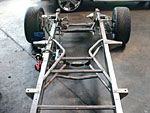
Much has been said, done, proved, and disproved about brakes over the years, and it seems that things are still advancing in the stopping department at an alarming rate. First, the industry tackled the issue of replacement and upgraded parts for older original brake systems, and did so with tremendous results. You can now buy an aftermarket brake upgrade kit for almost any classic car or truck in almost any configuration imaginable.
Now, couple that half of the industry with the high-performance market, combine that with the latest in big-diameter/multi-piston combos, and we get a bit of reinventing the wheel going on-sort of. Obviously, the idea is still the same-using a hydraulic system to get enough pressure to the calipers to stop a vehicle of a certain weight. Easy, right? Yes and no.
The brake systems on older cars were all engineered and refined until they worked and you bought the whole package in working order with the car. All of that engineering is done with all the new aftermarket brakes, but the thing we deal with now is putting these to work with the countless different applications that come about with any newly constructed chassis whether it is on a street rod, musclecar, or truck. There are many things to be considered when buying parts to assemble your own system. Small things-and we're not just talking about washers and fittings-can make a big difference in how your brakes work-like the bore size of your master cylinder, for example. Things like this can greatly affect how your brakes perform, and since those big brakes ain't cheap, you probably want 'em to work like they're supposed to.
Parts are parts, but part of building today's modern classics is to have unsightly things "out of sight and out of mind," which can mean searching for low-pro or shrunken pedal assemblies, brake boosters, master cylinders, and even then there's the question of whether your motor will have enough vacuum to run some of those? This is where the plot thickens and compromise forces you away from the optimal parts to make those brakes grab like they should.
Good thing for all of us, there are places like ABS Power Brake in Orange, California, who has been around the block many times in their attempt to make brake parts better. They caught on to this trend happening in the aftermarket, since they have their foot well into it, and came up with a solution-the Electric High-Power Master cylinder kit (EHPM). It uses an electric pump and an accumulator in lieu of a brake booster or a hydro boost, and needs no vacuum or belts to build proper pressure. It can mount to either the firewall, under the floor, or wherever you want to build the bracketry, and can also be used with a remote fill reservoir. The built-in accumulator makes it possible to get 20 more pumps out of the brake pedal if you lose power before returning to manual brakes. How could you say no to this? We don't know either, but team ABS's Electric High-Power Master cylinder kit with Inline Tube's stainless steel brake line kit and powerful Wilwood brakes all on a '55-59 Roadster Shop Chevy chassis, and you better have some seatbelts to hold you back during a hard stop.